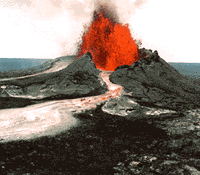What is a volcano?

Volcano is a place where ash, gases, and molten rock from deep underground erupt on the surface. The word volcano also refers to the mountain of erupted rock and ash that often accumulates at such a place.

Volcanic eruptions result from magma. It rises because it is less dense than the surrounding rock. Rising magma can collect below or inside a volcano in a region called a magma chamber. As the magma accumulates, the pressure inside the chamber increases. When the pressure becomes too great, the chamber breaks open, and magma rises in the volcano. If magma reaches the surface, an eruption occurs. The hole through which the magma erupts is called a vent.
If magma accumulates at a high enough rate, the volcano erupts almost continuously. The violence of an eruption depends largely on the amount of gas dissolved in the magma and the magma's viscosity (resistance to flow). Magmas with little gas produce relatively calm eruptions in which lava flows quietly onto the surface. Magmas with much gas can shoot violent jets of gas and ash high into the air. Volcanoes can create many dangers. Hot ash, gas, lava, and mud can bury or burn people and buildings near an erupting volcano. The most violent eruptions launch large clouds of ash and gas high into the atmosphere, causing problems far from the volcano itself.
Volcanic eruptions result from magma. It rises because it is less dense than the surrounding rock. Rising magma can collect below or inside a volcano in a region called a magma chamber. As the magma accumulates, the pressure inside the chamber increases. When the pressure becomes too great, the chamber breaks open, and magma rises in the volcano. If magma reaches the surface, an eruption occurs. The hole through which the magma erupts is called a vent.
If magma accumulates at a high enough rate, the volcano erupts almost continuously. The violence of an eruption depends largely on the amount of gas dissolved in the magma and the magma's viscosity (resistance to flow). Magmas with little gas produce relatively calm eruptions in which lava flows quietly onto the surface. Magmas with much gas can shoot violent jets of gas and ash high into the air. Volcanoes can create many dangers. Hot ash, gas, lava, and mud can bury or burn people and buildings near an erupting volcano. The most violent eruptions launch large clouds of ash and gas high into the atmosphere, causing problems far from the volcano itself.
Volcanoes also provide benefits. Erupted materials contain many nutrients and can break down to form fertile soils. Volcanic activity provides an important source of geothermal energy, energy from Earth's interior heat. Geothermal energy can power electric generators and heat water and buildings. Undersea volcanoes have built up over time to form islands on which millions of people live. Volcanoes also have inspired myths and legends in many cultures. The word volcano comes from Vulcan, the Roman god of fire.
There are 3 types of volcanoes
Shield Volcanoes

Shield Volcanoes are made mostly of fluid lava flows. Flow after flow pours from a central summit vent. It builds up and turns into what looks like a warriors shield. Some of the largest volcanoes in the world are shield volcanoes. Some have diameters of 3-4 Miles and are 1,500 to 2,000 feet high. The Hawaiian islands are composed of chains of shield volcanoes.
Composite Volcanoes

Some of the world's biggest mountains are Composite volcanoes. Some people call composite volcanoes stratovolcanoes. Some of the most beautiful mountains are composite volcanoes such as Mount Fuji, Mount Cotopaxi, Mount Shasta, Mount Hood, Mount Rainer and Mount St. Helens. Most composite volcanoes have a crater at the top with a central vent or a group of vents where lava comes out.
Cinder Cone Volcanoes

Cinder cones are the simplest kind of volcanoes. Cinder cone volcanoes have a bowl shaped crater and barely ever rise over one thousand feet. When cinder cone volcanoes erupt lava blows furiously into the air and breaks up into small pieces called cinders. There are many cinder cone volcanoes in western North America.
Mt. St. Helens

May 18th, 1980, 8:32 am (PDT). Mt. St. Helens Eruption was triggered by a 5.1 earthquake centered beneath the mountain.
57 people were killed as a result of the eruption. Of these, 21 bodies were never recovered from the blast zone.
57 people were killed as a result of the eruption. Of these, 21 bodies were never recovered from the blast zone.
Fun Facts
The largest volcano on earth is Mauna Loa on Hawaii’s Big Island. It is a massive shield volcano constructed by countless lava flows. When measured from the base to the top, the pile of lavas measures more than 17,000 m
More than 80% of the earth's surface is volcanic in origin. The sea floor and some mountains were formed by countless volcanic eruptions. Gaseous emissions from volcano formed the earth's atmosphere.
There are more than 500 active volcanoes in the world. More than half of these volcanoes are part of the "Ring of Fire," a region that encircles the Pacific Ocean.
Active volcanoes in the U.S. are found mainly in Hawaii, Alaska, California, Oregon and Washington, but the greatest chance of eruptions near areas where many people live is in Hawaii and Alaska.
More than 80% of the earth's surface is volcanic in origin. The sea floor and some mountains were formed by countless volcanic eruptions. Gaseous emissions from volcano formed the earth's atmosphere.
There are more than 500 active volcanoes in the world. More than half of these volcanoes are part of the "Ring of Fire," a region that encircles the Pacific Ocean.
Active volcanoes in the U.S. are found mainly in Hawaii, Alaska, California, Oregon and Washington, but the greatest chance of eruptions near areas where many people live is in Hawaii and Alaska.
Resources
www.worldbook.com
Library.thinkquest.com
www.volcanodiscovery.com
www.olywa.net
www.dosomething.org
Library.thinkquest.com
www.volcanodiscovery.com
www.olywa.net
www.dosomething.org

